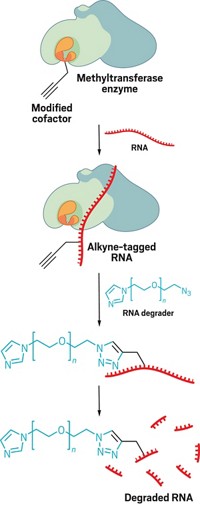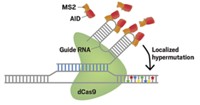Advertisement
Grab your lab coat. Let's get started
Welcome!
Welcome!
Create an account below to get 6 C&EN articles per month, receive newsletters and more - all free.
It seems this is your first time logging in online. Please enter the following information to continue.
As an ACS member you automatically get access to this site. All we need is few more details to create your reading experience.
Not you? Sign in with a different account.
Not you? Sign in with a different account.
ERROR 1
ERROR 1
ERROR 2
ERROR 2
ERROR 2
ERROR 2
ERROR 2
Password and Confirm password must match.
If you have an ACS member number, please enter it here so we can link this account to your membership. (optional)
ERROR 2
ACS values your privacy. By submitting your information, you are gaining access to C&EN and subscribing to our weekly newsletter. We use the information you provide to make your reading experience better, and we will never sell your data to third party members.
Gene Editing
New type of base editor works on mitochondrial DNA
Splitting novel bacterial toxin in two pieces enables the first precision gene editing in mitochondria
by Celia Henry Arnaud
July 8, 2020
| A version of this story appeared in
Volume 98, Issue 27

One type of DNA has remained beyond the reach of precision genome editing techniques like CRISPR. Mitochondrial DNA has remained inaccessible to those methods because the guide RNA molecules used to target specific DNA sequences to be edited can’t get into mitochondria. Researchers have now come up with a system that has performed the first precise edits in mitochondrial DNA (Nature 2020, DOI: 10.1038/s41586-020-2477-4).
“Being able to edit mitochondrial DNA is very important from both a basic biology and a disease perspective,” says Vamsi K. Mootha, an expert on mitochondrial biology at Harvard Medical School and the Howard Hughes Medical Institute (HHMI), who was involved in the new study. Some rare metabolic diseases are caused by mutations in this type of DNA.
Joseph D. Mougous and coworkers at the University of Washington School of Medicine and HHMI discovered a cytidine deaminase, which converts cytosine (C) to uracil (U), in the bacteria Burkholderia cenocepacia and thought the enzyme could be useful for genome editing. Mougous reached out to David R. Liu at the Broad Institute, Harvard University, and HHMI, because Liu’s group had previously developed base editors, which are engineered proteins that make specific single-letter changes in DNA.
B. cenocepacia make the protein as a weapon against other bacteria, so the protein on its own is toxic to cells. “We quickly realized that to use it as a genome-editing agent, we’d have to tame the beast,” Liu says. They decided to create an inactive version that didn’t indiscriminately edit Cs in DNA.
To make an inactive form of the enzyme, they split the protein into two pieces, each of which would be nontoxic. Marcos H. de Moraes, a postdoctoral fellow in Mougous’s lab, characterized and solved structures of the protein that helped Beverly Y. Mok, a graduate student in Liu’s lab, figure out the best places to split it.
Mok attached the pieces of the split deaminase to programmable DNA-binding proteins that guide the tamed enzyme to desired sequences on mitochondrial DNA. When those proteins land on a target DNA sequence, the two halves of the deaminase come together, reassemble, and become active. The researchers joined forces with Mootha’s lab to edit five mitochondrial gene targets in cultured human cells and characterize the effects of the edits.
“It’s far from perfect—and will benefit from additional rounds of engineering—but it’s a major leap forward,” Mootha says of the new technique.
“This new system definitely expands the potential of genome editing-based therapeutics and makes researchers dream about its applications in diverse fields of biology,” says Nozomu Yachie, a genome-editing expert at the University of Tokyo, who was not involved in the study.
CORRECTION
This story was updated on July 9, 2020, to correct the DOI for the Nature paper. The DOI is 10.1038/s41586-020-2477-4.





Join the conversation
Contact the reporter
Submit a Letter to the Editor for publication
Engage with us on Twitter